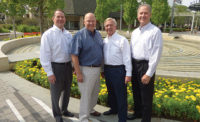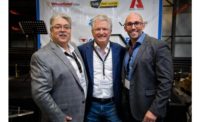The current PHCP-PVF manufacturing landscape easily could be labeled the “ease of use” era.
Manufacturers of PHCP-PVF products continue to have a keen eye on making the experience for both their contractor customers and the contractors’ customer base as easy as possible whether that be through means such as remote connectivity or via products designed to help contractors work as efficiently as possible on jobsites.
The hydronics portion of the pie is no different.
“We’ve learned through the years customers want simple efficiency not efficiency that requires lots of programming, charts and expert specialists,” Taco Comfort Solutions Vice President of Governmental Relations & Sustainability Mark Chaffee says.
A consistent theme for manufacturers that participated in this Supply House Times story centers around products and technologies that not only cater to the end-user’s needs in a digitally-centric society, but also are helping contractors and installers win in their businesses that remain hamstrung by a challenging labor market.
About that labor market…
“We are concerned about our customers’ needs for skilled labor and competitive advantage,” Legend Valve Executive Vice President Walter Jann says.
Uponor Commercial Segment Manager Aaron Stotko echoes a similar sentiment. “Looking at hydronics and the construction industry in general, we see some parallel trends,” he says. “Labor seems to boil to the surface in any discussion around what’s happening in the industry. The skilled labor shortage is creating challenges for contractors who need to meet project schedules in a profitable manner.”
Jann says Legend Valve is keenly aware of the labor situation and has a number of key initiatives in place to address this, including the company’s monthly Legend Hydronics University geared at training in hydronics at all levels. “Our customers have made it clear quality technical training is extremely important in today’s tight labor market,’ he says. “If we can help our customers engage, inspire and educate their young technicians, we help to make them not only better, stronger professionals, but we help business owners to nurture and retain them. If we at Legend Valve can do that for our customers, all the while improving our outreach amount installers, that’s a win-win recipe.”
Stotko says Uponor’s mantra in today’s current climate is to stress the importance of being easy to do business with. “It’s about ensuring we’re delivering a great experience for anyone using our systems throughout the construction process,” he says. “It’s much more than hanging pipe and making a ProPEX connection. It is making sure we’re adding value in every place we can.”
Stotko adds the company has noticed more construction work moving off the jobsite and into fabrication shops to help counter the labor shortage. “For us that means we need to shift with our customers to ensure our products can be integrated into any build strategy,” he says. “By focusing on these pain points and innovating to solve industry challenges, we can deliver this exceptional experience and be seen as a company that’s a desirable partner.”
Changing with the times
Like Legend Valve and Uponor, other manufacturers in the hydronics arena are innovating to meet the always changing needs of their customer base. “We constantly are getting marketplace feedback and are ensuring we are listening closely to engineers and contractors to drive new hydronic
system development,” says Ryan Westlund,
senior manager, radiant heating and cooling for
REHAU’s Building Solutions Division.
As an example, Westlund notes distributors are benefiting from REHAU’s LoopCAD design software that increases the support available to engineers and contractors, particularly for commercial project work. “The software provides quantitative data to help distributors make the case for hydronics,” he explains. “There is a wealth of experience among manufacturers that distributors can tap into for support with all construction phases from design charrets through jobsite installation crew training.”
Uponor’s Revit templates offer smart features such as built-in auto-routing preferences for easier design functionality. “We also have services that help reduce sunk costs in the bid-award phase of the construction process such as our in-house design and estimation teams that deliver the right information to help our customers win projects,” Stotko says.
Helping customers win business also goes well beyond products and software, as Precision Hydronic Products CEO Tom Amundson points out. “One of our best assets as a company is our domestically-sourced vendor resources and having one manufacturing facility for our hydronic and manifold products (in Portland, Oregon),” he says. “By keeping our processes under one roof, we have the ability to keep up with our customers’ demands while keeping lead times down.”
Legend’s Jann notes the Auburn Hills, Michigan-based manufacturer has a “downstream thinking” ethos as well as a 24-hour shipping promise for all orders. “We keep our inventory levels high and we ship so fast and accurately, our customers can save big just by letting us keep the supply line full for them,” he says. “We constantly strive to keep transactional costs out of doing business with us. Contractors can expect a job shipped complete, accurate and on time.”
Causes for concern?
Like many parts of the PHCP-PVF supply chain, the ongoing tariff topic reaches into the hydronics space. “Tariffs are a big wait and see what is going to happen right now,” Heat Link’s Randall Quon says. “Many customers are waiting to see what kind of price increases will be passed on because of the new tariffs.”
Taco’s Chaffee adds: “Current and proposed tariffs are hitting all these items and at a rate that simply cannot be absorbed by the manufacturer and will result in higher prices throughout the industry on almost every product category and type of product.”
Speaking of price increases, REHAU’s Westlund says material price volatility is something that has affected the hydronics industry the past 10 years, specifically with metals. “This has created a slight shift toward polymers as a sustainable group for building solutions because they experience less price fluctuation and are more cost-effective.”
So where is the hydronics industry headed amidst converging headwinds? Manufacturers have plenty of ideas. “Water quality,” Caleffi North America Engineering and Operations Director Mike Schreiner says in response to what the next big thing may be. “In order to fully capture the high efficiency of new products — boilers, pumps, heat exchangers — the quality of the hydronic fluid is critical. Magnetic separation to remove magnetite from the hydronic fluid will start to show up in nearly every system. Europe already has fully embraced this technology.”
Xylem’s George Carey sees hot-water systems being heated by refrigerant. “Some form of air-to-water heat pumps,” he says. “As VRF technology continues to develop, heat pumps will be able to provide water temperatures in the 160° to 170° F range in cold-weather climates.”
Uponor’s Stotko says integrated systems fall into the emerging trend category as well. “There is a greater desire to integrate mechanical systems to reduce first costs and increase energy efficiency,” he says. “It is something Uponor is looking at aggressively and sees as the future.”
Legend Valve’s Jann cites an increasing demand for lower-mass, lower-temperature flexible floating hydronic systems. “Because flooring and interior designers now are using many more ‘floating’ engineered and composite materials on floors, we are designing matching hydronic radiant systems that are perfect for them,” Jann says.
REHAU’s Westlund says despite challenges in the marketplace, the hydronics industry will continue to push forward. “Whether we are having discussions about tight labor pools or we’re talking about material pricing on a global scale, our industry has dealt with many of these challenges in the past,” he says. “A strong, growing construction market in North America will continue to push past any types of barriers to hydronics and we will be very resourceful with solutions.”







